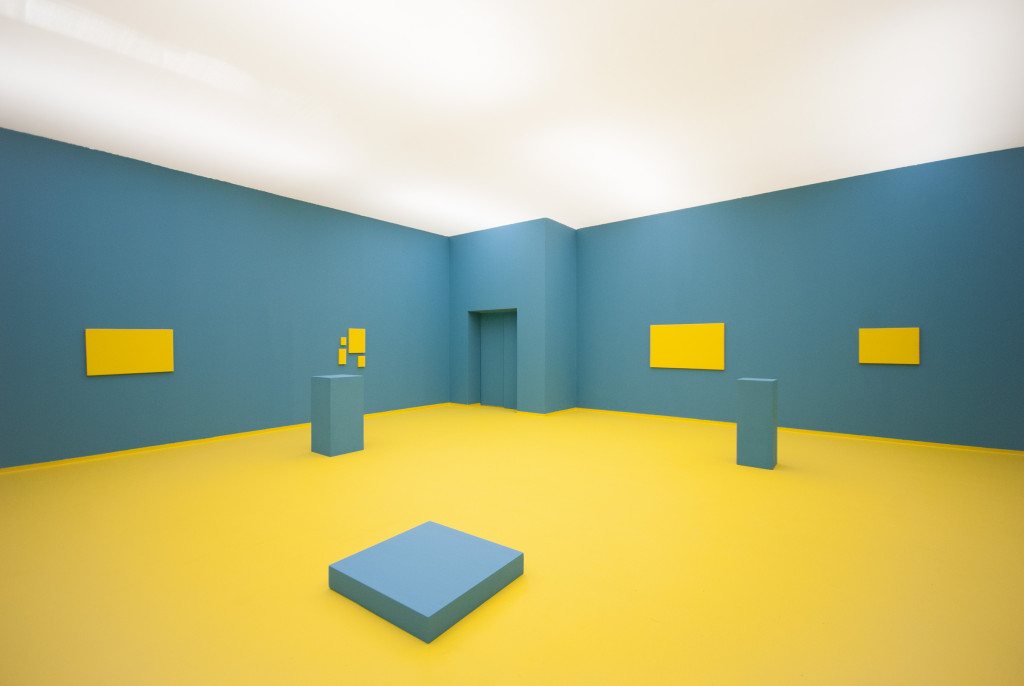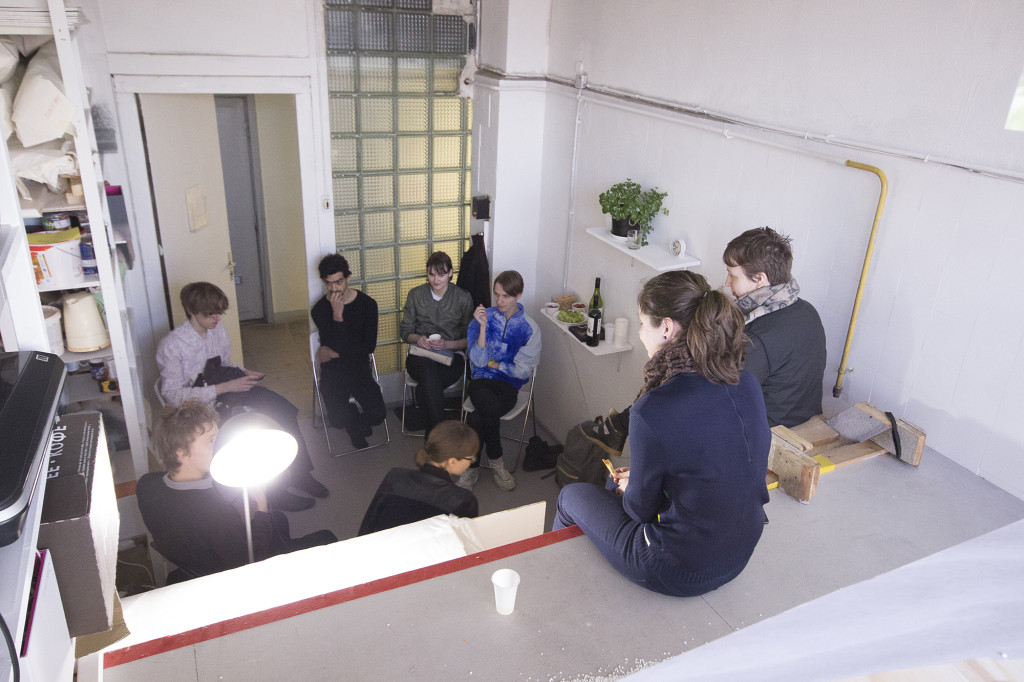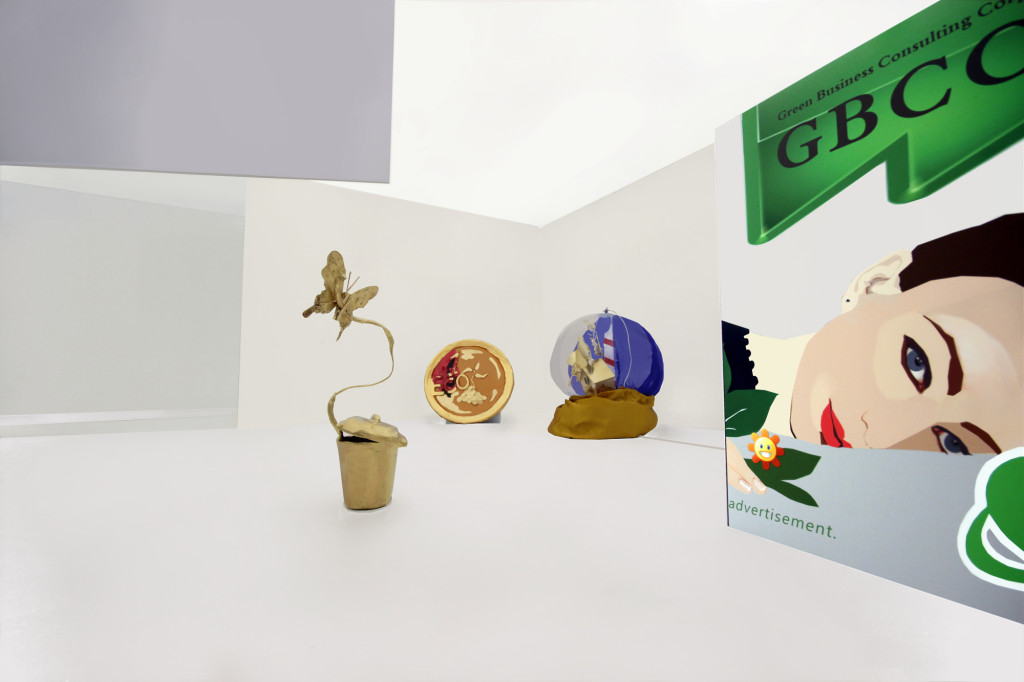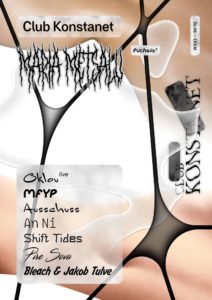Recently, a tweet, in a sort of proposition form, came up on my feed – “a museum – where nothing is online”. With varying levels of involvement and understanding, art institutions have embraced the digital. To market, to engage, to find or build relationships with audiences. Arriving at this new territory, communicating art to audiences in their everyday networks and environments has almost become the norm —further removing art’s basis in the exhibition visiting ritual, institution has a commitment added, of cultivating myths and cults online.
Located just off Tallinn’s city center in Estonia, Konstanet is an initiative set up in a shared studio space on the seventh of floor of an office building. It’s a non-profit gallery founded in 2013 that’s made up of two spaces: the online one at konstanet.com and a small physical space, scaled 1:5. Coordinated by Epp Õlekõrs and Keiu Krikmann and focussing primarily on international collaborations with young and emerging artists, the project has the aforementioned issues encoded in its exhibiting conditions. Rather than gesturing towards IRL ‘authenticity’ by attempting a distinction between the online and offline experience of an artwork, Konstanet does away with the distinction altogether.

Compared to the physical experience of an art platform, online experience is becoming entirely its own thing. Sharing policies, social media marketing strategies are thought of and declared internally. Artworks, historically, usually being experienced in contexts with a closer integration to art infrastructure, wind up having their representations circulating in a highly competitive climate of (visual) experiences, competing in structures built for accelerated content sharing. The institution, as a sort of optical device that allows us to experience the work, lost a considerable amount of control over the production of artwork’s context; its frame.
The documentation of an artwork, in bypassing these ‘caretakers’, also has found a new function –to represent and/or speak for the work online. With that came the obligation to be ready for the elastic life of the digital image and a spectrum of accidental contexts. The aura of the artwork has been “emancipated” in some ways. It has become more accessible, profuse, wider-reaching and deeply integrated within everyday visual culture. The artefact has had its metaphysical properties emphasised, almost taking a life of its own.
Jack Burnham, in a 1968 article in Artforum, almost prophetically contemplated the effects of technology on sculpture. “We are now in a transition from an object-oriented to a systems-oriented culture,” he argued, “here change emanates, not from things, but from the way things are done.” Nearly fifty years later, the boundaries of documentation –the artwork, and the experience of it –are still being redefined. It might be said, that a recent wave of new materialism(s) is just one of the ongoing struggles in contemplating the complications and the hierarchies of the entanglement of human, machine, and matter.
Provoking questions about these relationships, entanglements and experiences of art online is Konstanet. It is a system attentively thinking itself and one Õlekõrs and Krikmann discuss in an exchange, over email, as follows.
Tell me about how Konstanet started and what it is?
Konstanet: The main reasons for starting [it] was pure curiosity for playing with the possibilities and characteristics of a limited space, a desire to work with interesting young artists and their exciting ideas and a wish to create a platform for them; where exhibitions are viewable for a longer time than at offline galleries. And last but not least the endless possibilities of presenting art online – at the time it also seemed something that was missing from the local art scene.

On what principles do you select artists for the exhibitions? Have they changed over time?
K: The process of selecting artists can start in two ways –we either contact an artist whose work we like and think would suit our space or an artist contacts us and we decide upon working with them based on their proposal. But in any case there is no point in denying – in the end it comes down to our personal preference. Also, since Konstanet is a rather particular space, we also need to consider how an artist’s work would play out in the two spaces. The process of selecting has not changed much, we have never had a set ‘theme’. We want to present and we are open to different kinds of projects. Although, yes, the issue of art in online and offline spaces is encoded into Konstanet and will be present anyway because of the way the space is structured, but the works do not have to explicitly address the issue and the artists can choose to what extent they want to engage with it.
How do the conditions of the space influence the artists? Do you think it’s important the artists actually come to the space?
K: The physical space has a big influence on projects, for sure, it is an unusual one to work with. Maybe not so much because of Konstanet’s position on the borders of online-offline realms, which is not unusual for an art space/initiative, but in terms of the small size and role/significance of the physical space. Although the exhibition as a whole would ideally come together as a combination of the two spaces, from the point of view of the artist, the small size of the white cube can be quite demanding.
It is not that important to come to set up the installation in person. We are perfectly fine with installing it ourselves and we’ve done this many times, but this needs close collaboration and communication between us and the artist.
The conditions of exhibiting in Konstanet force you to think a lot about issues of representation. Like, where does the artwork stop and its documentation begin and the entanglement of ‘the digital’ and ‘the material’ (IRL versus URL – virtual versus real, and so on). How do you see this separation, or entanglement, yourself and how do you prefer to describe it?
K: Konstanet as a whole makes the questions of representation and the relationship between the digital and the material clearly visible –for us it is not about ‘IRL versus URL’, but finding ways to bring the two together; it is about entanglement, as you said. The space also draws attention to the importance of online representation of artworks, since in Konstanet’s case the process of documentation actually influences the result, probably more than in other spaces. Already while setting up the installation in the physical space, the artists have to focus on how they want to document it and that has an impact on the choices they make. For example, in order to be able to get better installation shots, they may have to reconsider the positioning of some elements. There are certain angles within the space that work better for taking photographs, so the installation needs to be set up in a manner that the photographer would be able to capture it in the best possible way.

This also relates to creating fictions or fantasies with installation shots that are quite different from the way art looks IRL. Or, a more cynical way of saying it would be ‘faking it for the sake of marketability’. But again, when it comes more specifically to Konstanet, this effect is amplified. Being inside the small white cube after the installation has been set up makes you feel very strange, you become very aware of your physical existence and the fact that your experience is incomplete. Part of it has to do with the fact that the space is too small for a person to comfortably move around in, as you are so close to the installation that you might accidentally break it. But you also can’t experience the exhibition in full, the online part is missing, so the fantasy the exhibition aims to trigger can not be experienced fully in the physical space (which is why we rarely open it to visitors).
So maybe in some cases images/documentation can be as good as the ‘real thing’. Since they kind of have to strive towards that anyway –so much art is looked at via digital images, often it is the only way to experience a work of art. We’re not exactly sure if there’s a ‘correct’ way of documenting exhibitions, because, as we just said, sometimes installation shots have to communicate the work of art in place of the actual work itself. But in order to achieve that the images need to be enhanced a lot, so in a way it is not necessarily documentation anymore (although no documentation is ever ‘neutral’ or ‘a situation recorded as it was’), it becomes something else. If we think about exhibition as a spatial experience then ideally the most precise (not correct) way to document an exhibition would be to offer the audience a multitude of options (photos, videos, 3D spaces, holograms, augmented reality etc) for approaching the space and artworks, be it only visual or something more tactile.
Harun Farocki was of the opinion that computer graphics can liberate cinema, or surpass it. He more or less said that the era of cinematic/cinematographic reproduction is over. Do you see something similar happening to the IRL exhibition experience? How is it being ‘liberated’ (or corrupted) by online platforms and/or images?
K: ‘Not sure if words like ‘liberated’ or ‘corrupted’ are the best ones to use here, there is a little too much value judgment in them. But online platforms and digital imagery have definitely changed how we look at art and it has also changed the way art is made. That being said, it is rather unlikely that physical exhibition experience would be replaced by online formats, people as bodies still very much inhabit physical spaces and value bodily experiences. So on the one hand, art is increasingly experienced digitally, but at the same time, if you look at what artists work with, a clear fascination with material, the very physical qualities of materiality has emerged over the recent years.

In light of Pierce Brosnan taking a picture of a design object and posting it on Instagram a day before its auction, and the work fetching a record price afterwards, and Leonardo di Caprio buying an artwork having only seen it on the same social platform, how do you think the documentation, the image of the artwork, participates in the art market? How does posting it on a gallery’s website, Instagram, Twitter, or Facebook differ? You seem to post different images on different platforms.
K: konstanet.com is the site where the exhibition takes place, it is not a place for posting documentation (two spaces make up a whole) and social media creates a network of rhizomes around the site, makes it alive – compared to social media, our website is rather static. It was set up with the purpose to showcase our projects and archive Konstanet’s past. And this network is really important to us, since Konstanet’s existence is fragmented – it’s physical space does not play a significant role in our everyday work. Most of it is done with our laptops and online, our specific geographic location is not that important –online, there is no home base.
And yes, we do post somewhat different content on different sites. It is a way of displaying the different sides of what we do. F or us the online environment is a place to reach out, our IRL events are small and rare. Also no one really likes to see the same things posted over and over again, people get annoyed easily online. Since we are a non-commercial and non-profit gallery, our social media presence connects us to the art market only in indirect ways. But it is true that the circulation of images does immensely influence the ways in which elements of the art world are perceived, and in an indirect way Konstanet profits from it as well, we are no exception.
I like to think about how much geographical boundaries are still very present online, through filter bubbles, social networks, localization of content and so on. – What position do you think Konstanet takes when participating in these art networks and markets, especially with this project being both physically grounded in Tallinn and online? What is your position in what appears still a very centralised art market and who are you providing the space for?
K: We absolutely agree –this is also a topic we explored during our brief involvement with Official Office. We ran a programme titled ‘Digital Peripheries’, which set out to explore the various ways in which the digital realm might provoke new ways of thinking about the meaning of notions like ‘centre’ and ‘periphery’. Although we mostly work online and at first glance our geographic location does not seem that significant, it actually matters a lot. It becomes especially apparent when you are located in a peripheral area like Estonia –our physical bodies still occupy space and the (geographical and cultural) context we as coordinators live in also influences and shapes what we do at Konstanet.
It is such a complicated issue to make sense of –as a (mostly) online gallery, we do have to consider the whole discourse around art and digital culture and try to position ourselves both in a wider context and in terms of the local art scene. On one level there’s the argument that a lot of issues concerning art and digital culture –even though they seem like global phenomena –are still produced in large Western (art) centres and only reach further areas, like the Baltics for example, as an import. And that these imports also serve as a way of integrating the more or less remote areas into the global art world. On another level though, if you look at artists or other art workers and art initiatives who are just starting out –who do not necessarily have that many resources and institutional connections, or who would like to work somewhat outside those connections –the internet is really a valuable tool for linking up with people with similar interests outside their own geographic location. But even in this case, there is, of course, still a difference in resources and in what you physically have access to.
But coming back to Konstanet and the question of its audience –Konstanet mostly exists online, our visitors often remain anonymous, although Google Analytics provides us with information about their location, language, devices used to look at our website. And this anonymity was something we struggled a lot with when we started out –sometimes it was difficult to position Konstanet in relation to our audience. However, over time we found our niche, made connections with people with similar interests and received a lot of positive feedback for which we are genuinely grateful.
But still, it is hard to give a definitive answer to the question of ‘who is it for’. It’s for anyone who relates to themes Konstanet presents. **
Konstanet is an online and Tallinn-based project space.
Header image: Konstanet comparative measurements, modelled by Epp Õlekõrs & Keiu Krikmann. Photo by Raiko Suits.
















